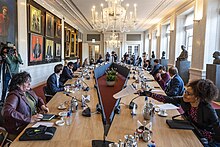
The formation of a Dutch cabinet is the process of government formation of a Dutch cabinet, consisting of ministers and state secretaries. Most cabinet formations take place after elections for the House of Representatives, but these can also take place in between.
There are no legal provisions regarding the manner in which a formation takes place. Only the appointment of ministers at the end of the formation by the head of state is laid down in the Constitution. In customary law there is the confidence rule, which states that the cabinet to be formed must have the confidence of the majority of parliament. Under the parliamentary system, sufficient support is also required to adopt bills. These rules are supplemented with conventions, traditions and customs, which have arisen and changed over the years.

The formation can be roughly divided into three phases. During the scouting phase, a scout or informateur explores which political parties want to form a cabinet together. In the subsequent information phase, negotiations will take place under the leadership of an informateur about the government's future policy programme, to be recorded in a coalition agreement. During the formation phase, under the leadership of a formateur, the portfolios are determined, divided among the parties and ministers and state secretaries are sought. What is discussed in the different phases is not fixed and if a phase does not lead to the desired result, one can go back to an earlier phase. At the end, the people who will take their place in the cabinet are appointed and sworn in by the monarch. The formation is finished with a government statement and debate in the House of Representatives.
© MMXXIII Rich X Search. We shall prevail. All rights reserved. Rich X Search
